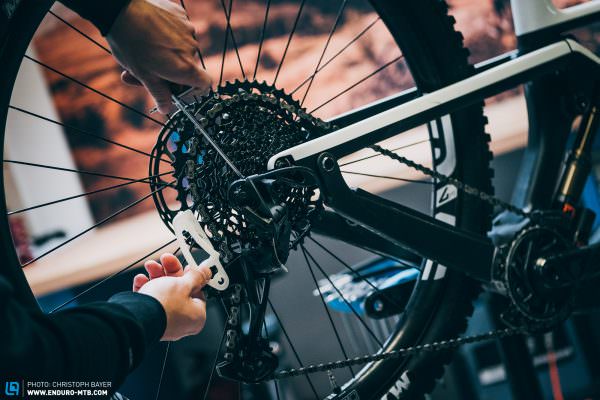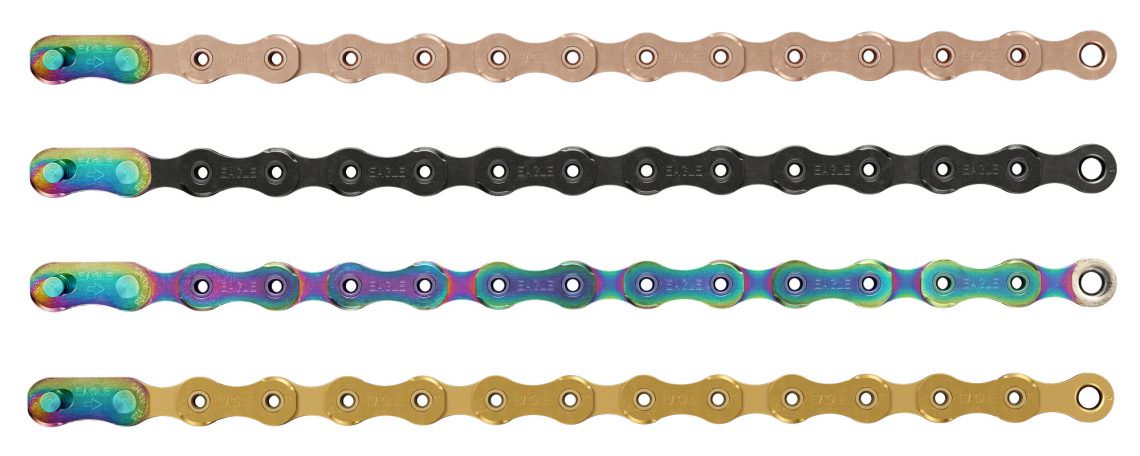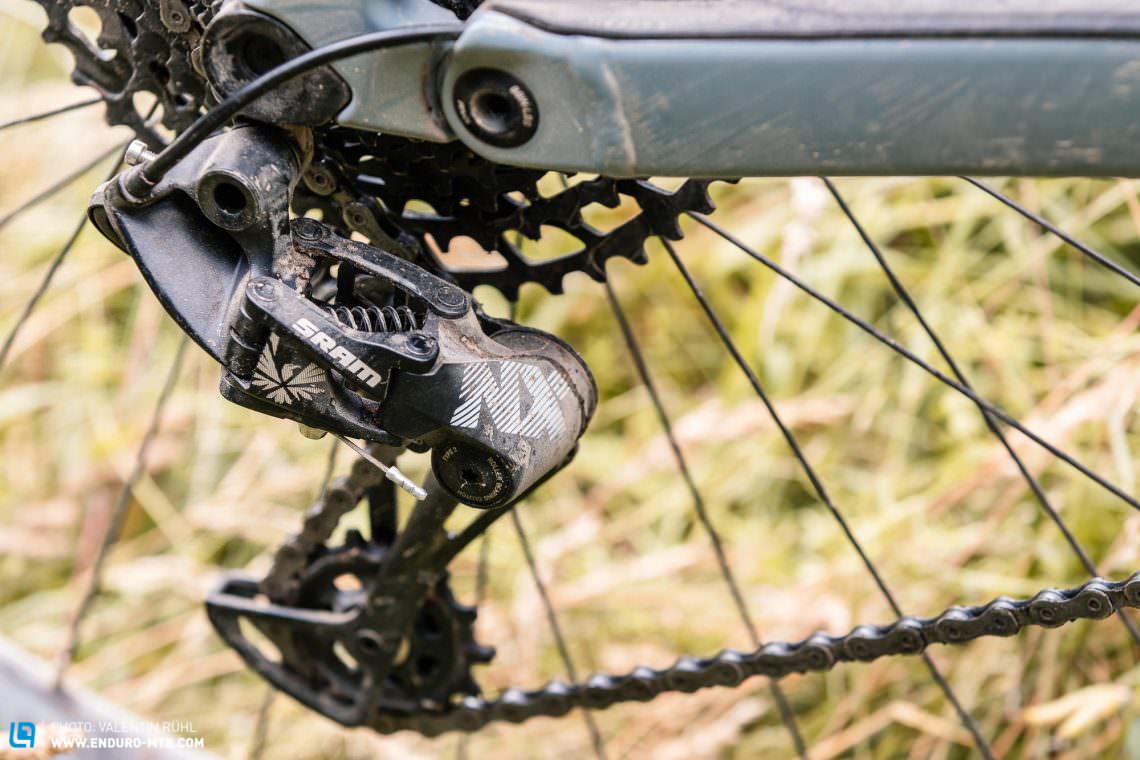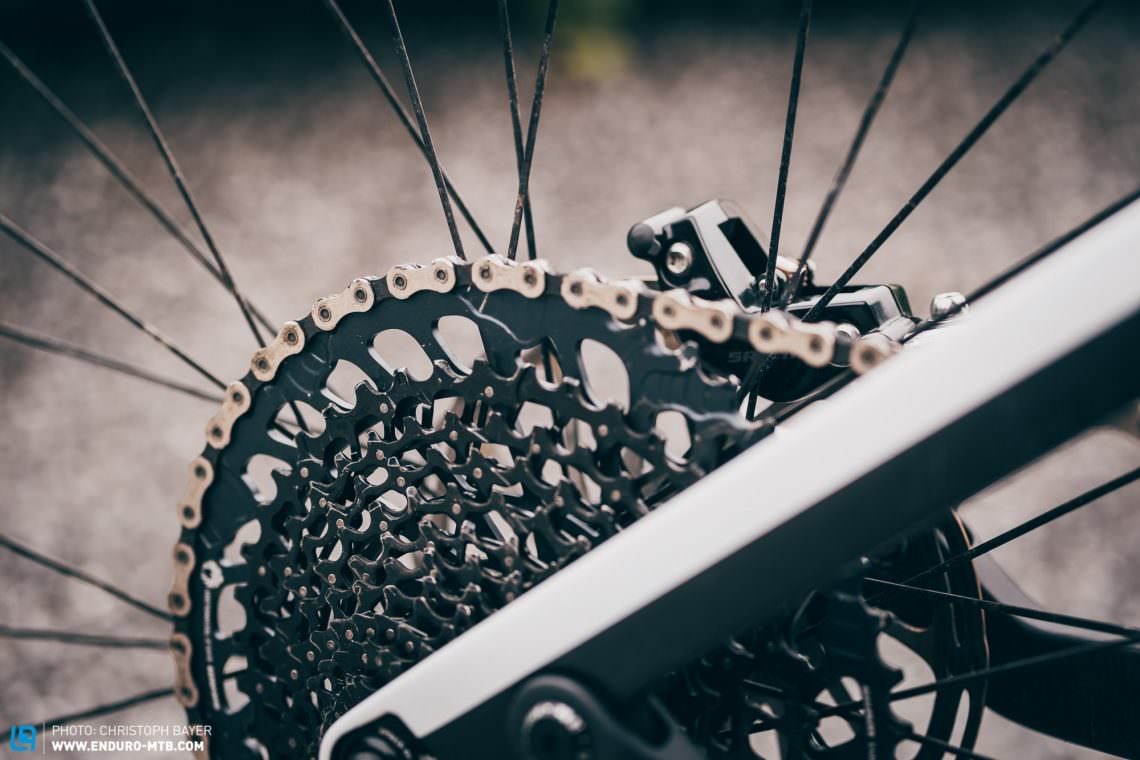SRAM have revolutionised the mountain bike market with their 1×12 Eagle groupset. Now they’ve updated their GX, X01 and XX1 groupsets, giving you the option of an even bigger cassette with a gear range of 520%. But is a bigger gear range really better? We’ve had the SRAM GX Eagle 52 on test for several weeks.

What’s new about the SRAM Eagle 52 drivetrain?
At first glance, SRAM new Eagle 52 components in the GX, X01 and XX1 ranges look almost exactly like their predecessors. Instead of new technology, it’s the new finish and the new colours of the groupsets that you’ll notice first. SRAM’s technical changes have been reserved primarily for the cassette and the position of the pulley wheels on the rear derailleur. As the name suggests, the Eagle 52 cassettes now have two extra teeth on the largest sprocket while the other sprockets remain unchanged. The gear jumps on the cassette remain the same except for the last one. With the new sprocket, the gear range increases to a whopping 520%, putting it 10% ahead of Shimano once again.

To ensure smooth shifting from the second largest to the largest sprocket, SRAM have revised the position of the pulley wheels, though other aspects such as the damping remain unchanged. Unfortunately, the previous derailleurs aren’t compatible with the new cassette, except for the SRAM AXS derailleur which has been designed with the new cassette in mind. SRAM have revised the design of the derailleur. This means that the pulley wheels have been repositioned slightly to better manage the larger jump on the cassette.


Same price and almost the same weight!
Despite the increased gear range, almost nothing has changed in terms of pricing and weight of the GX Eagle groupset that SRAM sent us for testing. The price of the cassette remains unchanged at € 220. The weight has increased only marginally from 450 to 452 g, which is absolutely negligible. The weight and price of the derailleur and other components also remain unchanged. The GX shifter is priced € 41 and the derailleur costs € 124. The complete GX drivetrain will set you back by € 555.

SRAM have developed a new tool to make setting the B-gap even easier
Along with the revised Eagle 520, SRAM have also introduced a new tool to adjust the chain gap. To set the distance, shift up into the second-largest gear, slide the tool onto the largest sprocket and then adjust the distance until the arrow is directly in line with the centre of the guide pulley. Note: since the chain usually lengthens as full-suspension bikes cycle through their travel, this adjustment should be made with the suspension at sag. As with SRAM’s previous chain gap tool, the new tool is compatible with all Eagle components.



Adjust the preload so that the arrow in the bottom hole of the template lines up with the centre of the guide pulley. Note: adjusting the preload on a full-suspension bike shouldn’t be done in the work stand as shown, instead, the adjustment should be made at sag with you sitting on the bike and a second person helping you adjust the derailleur.
50 or 52 teeth: the choice is yours!
SRAM’s new 52 t cassette isn’t going to replace the current 50 t version, instead, it is intended to supplement their range. With the new GX, X01 and XX1-Eagle range of groupsets, customers will be able to choose the cassette and gear range they prefer. The new derailleur is backwards compatible and works with both the 52 t and 50 t cassette.
New colours and an even classier finish for custom bikes
Besides revamping the derailleur and cassette, SRAM have also added new colour options to the GX, X01 and XX1 Eagle groupsets. As usual, the various Eagle components are cross-compatible with each other within their ecosystem. The SRAM X01 derailleur and the X01 shifter are available in a red and black variant. The range-topping X01/XX1 cassette and chain will be available in a choice of four colours: black, rainbow, gold and copper, giving you even more options when customising your bike.



The SRAM GX Eagle groupset gets carbon cranks
Until now, the SRAM GX Eagle groupset was only compatible with aluminium cranks. However, for the 2021 season, the groupset will also feature a carbon option. They weigh 65 g less and look quite a bit fancier but at € 290, they also cost € 140 more than the aluminium version. While the aluminium cranks are available in lengths of 165, 170 and 175 mm, the carbon version only comes in 170 and 175 mm lengths. Both cranks rely on a direct-mount chainring that picks up on the design of the crank – nice!

Is SRAM’s new 52 t Eagle cassette backwards compatible?
In addition to the new cassette, you’ll need the new derailleur to be able to make use of SRAM’s biggest range Eagle yet. You’ll be able to use the shifter, chain and crankset of the previous generation as long as they’re not worn out or defective. Only the SRAM AXS derailleur is compatible with the new, bigger gear range, where you’ll simply have to upgrade the cassette.

Is the new 52 t cassette compatible with SRAM’s NX or SX drivetrain?
Unfortunately, no. The new cassette with a 520% gear range is only compatible with SRAM’s GX range and upwards. Since SRAM’s NX and SX-Eagle groupsets rely on cassettes that mount to classic HG freehub bodies, they’re not compatible. The cassettes of this range stay at 11-50 t with a 455% gear range.

How does the new 2021 SRAM GX Eagle 52 perform on the trail?
Enough of the theory. How does the new GX Eagle perform on the trail? How does the chain shift to the new, larger sprocket? What are the gear jumps like and who will be happy with the new Eagle 52?
We tested the drivetrain on a Canyon Strive CF for almost two months, riding in both extremely dusty and muddy conditions. Maintenance was kept to a minimum and we didn’t crash during this time. The new finish of the SRAM GX Eagle groupset immediately caught our eye. It looks a lot classier than the previous year’s model, though it still has the same features and technologies. Installing it on your bike is done the exact same way as you’re used to from the previous generation drivetrains. The chain length is identical despite the larger cassette. Only riders who’ve shortened their chain to the absolute minimum may have to add two extra links. Setting the derailleur B-gap is easier with the new tool and once you’ve adjusted the tension of the shifter cable and the limit stops, you’re ready to go.


The shifting performance is exactly what you’re used to from SRAM. Fast, crisp and precise. Nothing has changed here compared to the predecessor. It’s not surprising considering that all but the largest sprocket of the cassette and the shifter have remained unchanged. The big question here is: how does the chain shift to the largest sprocket? Even after weeks of abuse, the drivetrain shifts into the biggest gear very reliably, quickly and with almost no interruption in power transfer. We didn’t notice any difference compared to the 50 t version – thumbs up! Logically, the gear jump itself is somewhat bigger. With the Eagle 50, you have a 19% jump from the 42 t to the 50 t sprocket and on the new Eagle 52, it’s around 24%. Riding alone, this difference was negligible, giving us a slightly easier gear on those nasty, steep climbs. Only in isolated situations when riding in a group did we get the impression that the gear jump was a little too big. The easiest gear was slightly too easy and one gear down was just a little too hard, but the difference is very subtle.

SRAM haven’t made any changes to the clutch of the GX derailleur. In the past, we occasionally got the impression that the tension of the clutch would decrease over time during long-term reviews. It’s too early to say whether this is the case with the new GX 52. However, the new derailleur still doesn’t give you the option of adjusting the tension of the clutch.

How does the SRAM GX Eagle 52 perform on an eMTB?
Besides testing the new SRAM GX Eagle 52 on an analogue enduro bike, we also had a second groupset on test that we installed on a Specialized Levo eMTB. As usual with SRAM, the eMTB version comes with a special Single Click shifter to prevent you from double shifting and putting excessive lateral stress on the drivetrain. Even the increased demands of the motor didn’t affect the drivetrain’s shifting performance during the course of our review. The shifting is just as smooth and quick as on an analogue bike. However, you’re unlikely to need the super easy 52 t gear on an eMTB very often. However, if you want to maximise your climbing capabilities and regularly tackle almost non-rideable ascents, you’ll be happy about the added gear range. On super long rides in ECO mode, the easy gear will also allow you to keep your cadence up even with minimal support where the motor will perform at its most efficient.
Will the SRAM 52 cassette allow me to use a larger chainring up front?
If you’ve got an easier gear at the back, it could mean that you’ll be able to mount a larger chainring up front. However, this is not the case for most riders. The difference between 50 and 52 teeth on the cassette is smaller than the difference between 30 and 32 teeth on the chainring. Instead of mounting a larger chainring, you’ll get more benefit from having a slightly easier gear uphill.

Our conclusion on the new 2021 SRAM GX Eagle 52
The update of the new, 2021 SRAM GX Eagle 52 delivered a convincing performance. The additional gear range makes life a little easier, especially on very steep climbs, without a compromise in shifting. The new finish of the GX looks classy and even after several weeks of abuse, the drivetrain didn’t show any weaknesses. In future, we’d like to see SRAM update the derailleur’s clutch for an even more effective damping and an even quieter ride.

For more information head to sram.com
Did you enjoy this article? If so, we would be stoked if you decide to support us with a monthly contribution. By becoming a supporter of ENDURO, you will help secure a sustainable future for high-quality mountain bike journalism. Click here to learn more.
Words & Photos:









